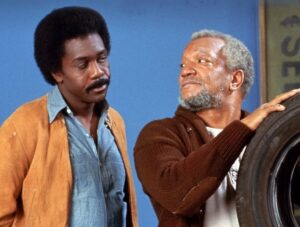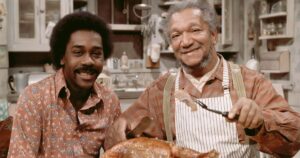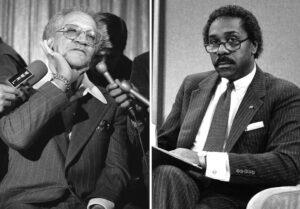
From failed spin-offs to Redd Foxx’s real name, get all the secrets here!
TV viewers may remember Thursday nights as NBC’s evening of “Must See TV,” but back in the 1970s that would actually be Friday nights, especially during the 1974 to 1975 season with Sanford and Son kicking things off and leading into Chico and the Man, The Rockford Files and Police Woman. But the true standout, however, was Sanford and Son, which ranked in the Top 10 rated shows during its first five seasons (coming in at No. 2 in two of those years).
Sanford and Son, which ran from 1971 to 1977 with 136 episodes produced, stars Redd Foxx as widower Fred Sanford and Demond Wilson as his son, Lamont. The two of them run the Sanford & Son junkyard, providing huge laughs for viewers and amazing chemistry between each other as they’re constantly butting heads with their different views of the world.
Surroudning them were recurring characters like LaWanda Page’s ultra-religious Esther Anderson, Whitman Mayo’s Grady Wilson, Nathaniel Taylor’s Rollo Lawson, Gregory Sierra’s (Chano from Barney Miller) Julio Fuentes, and Pat Morita’s (Arnold from Happy Days) Ah Chew.
From behind-the-scenes dynamics to the fact there were actually three spin-offs to the show, what follows are 10 facts you may not know regarding Sanford and Son, one of the most innovative sitcoms of the 1970s.

1. Redd Foxx Had to Clean Up His Act For ‘Sanford and Son’
Redd Foxx enjoyed a brilliant — but verbally filthy — stand up career prior to Sanford and Son, which Norman Lear happened to catch in Las Vegas and instantly knew he should be starring in a TV show. Lear told USA Today, “We met with him and came back to LA sky high. Miraculously, several days later a British agent came to us with the idea of making an American version of a big hit in Britain entitled Steptoe and Son. It was an instant marriage. Not that he wasn’t difficult to deal with, but he was funny as hell and that made everything possible.”
2. Demond Wilson or Richard Pryor?
Demond Wilson, a Vietnam veteran, was a stage performer in New York, had appeared in several films and made a guest appearance on All in the Family, which led to his being approached to play Lamont on Sanford and Son. Maybe.
As he told the Associated Press, “They said, ‘We were considering Richard Pryor and I said, ‘C’mon, you can’t put a comedian with a comedian. You’ve got to have a straight man.’ Dick Martin was the nut, Dan Rowan was the straight guy on Rowan & Martin’s Laugh-In.” He must have made his point, because he was cast alongside Redd Foxx.
3. ‘Steptoe and Son’
In the same way that All in the Family was based on the British sitcom Till Death Do Us Part, Sanford and Son was based on that country’s Steptoe and Son. That show spanned eight seasons (or “series” as they’re referred to in the UK) for a total of 57 episodes airing between 1962 and 1974.
The show stars Wilfrid B
Back in the 1970s, there were many people who thought Sanford and Son was a spin-off of All in the Family, but outside of the fact that Norman Lear serves as executive producer of both, there were no other connections. In making the shows, Lear said, “We didn’t compare them, but the characters called it like they saw it in their own neighborhoods.”
For his part, Demond Wilson agreed, noting, “There is no comparison, really. The two shows have nothing to do with each other. I think they’re both bold shows, but they’re entirely different. Red Foxx’s Sanford is not a bigot. He’s just a cantankerous old man who will straighten out anybody if they’re wrong.”
None of which dissuaded Foxx from liking the idea of a crossover at the time. “I’ve thought about it quite often,” he said, “and I wish it could happen. Maybe somewhere they might have put a special together or something like that.”
6. The Relationship Changed Between Sanford and Son

According to an interview he gave to Get.tv, Demond Wilson says that his relationship with Redd Foxx was an evolving one that went from good to great to… disappointing: “It went from mentor to father/son, to older brother/younger brother. Whatever they said to Redd, he said, ‘Go ask my son. Whatever he wants to do, that’s what we’ll do.’ We hit it off right away. Redd was straight up street, as was I. [At one point] I told Redd, and I told the producers, ‘I will do the show as long as Redd wants to. When he doesn’t want to do it anymore, I’m out.’ They were gonna replace Redd. They wanted me to do publicity shots with Whitman Mayo [Grady] and I refused. That’s when Redd and I really bonded, because word went back to him that Demond is standing strong; he’s standing with you. [And] we never had a beef until he walked away from the show, put it in the paper and didn’t say anything to me about it. And after the show went off the air in ’77, I didn’t speak to Redd again until 1983.”
7. The ‘Sanford and Son’ theme Song Was by Quincy Jones
The theme song for Sanford and Son was composed by music legend Quincy Jones, though it wasn’t originally designed for it. The track’s actual name was “The Streetbeater,” and it was released as a part of Jones’ first album released in 1973 by A&M Records, You’ve Got It Bad Girl. The TV show version ran less than a minute, while the full length version — as can be heard in the video above — ran 3:06. Rolling Stone featured a reader’s poll of television theme songs, and ‘The Streetbeater’ came in at number nine.
8. ‘Grady’ (1975 to 1976) was short-lived
Created while Sanford and Son was still on the air, this first spin-off focused on Fred Sanford’s best friend, Grady Wilson, as played by Whitman Mayo.
In the show, Grady travels to Westwood, California to move in with his daughter and her family. Norman Lear, who served as executive producer of Sanford and Son, was a consultant. Also starring were Carole Cole as Grady’s daughter, Ellie Wilson Marshall; Joe Morton as his son-in-law, Hal Marshall; Rosanne Katon as his granddaughter, Laurie Marshall; and Jack Fletcher as Mr. Pratt. Apparently the audience liked Grady hanging out with Fred, but no much without him. Grady lasted 10 episodes.
9. Half of ‘Sanford Arms’ (1977) episodes aired

When Redd Foxx elected to leave Sanford and Son after its sixth season (he went to star in on a short-lived variety show on ABC), NBC planned on continuing the series with Demond Wilson as the star. But because they refused to pay him what he felt he should be getting for series lead, Wilson walked. Instead of just cancelling the show, the network produced eight episode of Sanford Arms, second spin-off to the original series.
The concept was that the Sanfords sold the property to widower Phil Wheeler (played by Theodore Wilson), who lived with his two daughters in the Sanford’s home. He also took over running the the next door rooming house that the Sanfords purchased towards the end of the show. As Phil tried to turn it into a successful hotel, he’d interact with characters from the original series, among them Whitman Mayo’s Grady, Don Bexley as Bubbs and LaWanda Page as Aunt Esther. The audience obviously didn’t go for it. Only four of the eight episodes produced actually aired.
10. Why ‘Sanford’ (1980 to 1981) didn’t work
Trying to cope with the quick cancellation of The Redd Foxx Comedy Hour, Foxx went back to NBC and tried to pick up where he left off with the third Sanford and Son spin-off, this one simply titled Sanford.
While they attempted to surround Fred Sanford with a number of new characters, no one could replace his interactions with Demond Wilson’s Lamont and the comedy — airing only a few years after the end of the original — just didn’t work. Ratings started off strong, but quickly dipped off and the show was pulled off the air after 26 episodes that spanned two seasons.
rambell (who played Paul McCartney‘s grandfather in The Beatles film A Hard Day’s Night) as junkman Albert Steptoe (considered a “dirty old man”) and Harry H. Corbett as his son, Harold Steptoe, who is pretentious and has aspirations of lifting his societal status. Both work as junkmen and there is, naturally, generational conflict between the two of them. In addition to America’s Sanford and Son, it inspired Sweden’s Albert & Herbert, the Netherlands’ Stiefbeen en zoon, Portugal’s Camilo & filho and South Africa’s Snetherswaite and Son. There were also the feature films Steptoe and Son (released in 1972) and Steptoe and Son Ride Again (1973).
4. Redd Foxx’s Actual Name Was Sanford
Redd Foxx was actually born John Elroy Sanford on December 9, 1922 in St. Louis, Missouri, which made his starring in Sanford and Son even more meaningful for him. In detailing how the change in name came, he told British interviewer Bobbie Wygant, “I was searching for a name that could be remembered by everyone, and I thought about Red Fox. A kid three or four could remember Red Fox; that’d be a good name. So I added the extra D and extra X to make it a name instead of the animal or the color an an animal. And it worked out pretty well. Now, some of my dearest friends call me Sanford, so it is odd for me to turn around and answer, because Sanford is my family name.”
5. ‘Sanford and Son’ vs. ‘All in the Family’
Back in the 1970s, there were many people who thought Sanford and Son was a spin-off of All in the Family, but outside of the fact that Norman Lear serves as executive producer of both, there were no other connections. In making the shows, Lear said, “We didn’t compare them, but the characters called it like they saw it in their own neighborhoods.”
For his part, Demond Wilson agreed, noting, “There is no comparison, really. The two shows have nothing to do with each other. I think they’re both bold shows, but they’re entirely different. Red Foxx’s Sanford is not a bigot. He’s just a cantankerous old man who will straighten out anybody if they’re wrong.”
None of which dissuaded Foxx from liking the idea of a crossover at the time. “I’ve thought about it quite often,” he said, “and I wish it could happen. Maybe somewhere they might have put a special together or something like that.”
6. The Relationship Changed Between Sanford and Son
According to an interview he gave to Get.tv, Demond Wilson says that his relationship with Redd Foxx was an evolving one that went from good to great to… disappointing: “It went from mentor to father/son, to older brother/younger brother. Whatever they said to Redd, he said, ‘Go ask my son. Whatever he wants to do, that’s what we’ll do.’ We hit it off right away. Redd was straight up street, as was I. [At one point] I told Redd, and I told the producers, ‘I will do the show as long as Redd wants to. When he doesn’t want to do it anymore, I’m out.’ They were gonna replace Redd. They wanted me to do publicity shots with Whitman Mayo [Grady] and I refused. That’s when Redd and I really bonded, because word went back to him that Demond is standing strong; he’s standing with you. [And] we never had a beef until he walked away from the show, put it in the paper and didn’t say anything to me about it. And after the show went off the air in ’77, I didn’t speak to Redd again until 1983.”
7. The ‘Sanford and Son’ theme Song Was by Quincy Jones
The theme song for Sanford and Son was composed by music legend Quincy Jones, though it wasn’t originally designed for it. The track’s actual name was “The Streetbeater,” and it was released as a part of Jones’ first album released in 1973 by A&M Records, You’ve Got It Bad Girl. The TV show version ran less than a minute, while the full length version — as can be heard in the video above — ran 3:06. Rolling Stone featured a reader’s poll of television theme songs, and ‘The Streetbeater’ came in at number nine.
8. ‘Grady’ (1975 to 1976) was short-lived
Created while Sanford and Son was still on the air, this first spin-off focused on Fred Sanford’s best friend, Grady Wilson, as played by Whitman Mayo.
In the show, Grady travels to Westwood, California to move in with his daughter and her family. Norman Lear, who served as executive producer of Sanford and Son, was a consultant. Also starring were Carole Cole as Grady’s daughter, Ellie Wilson Marshall; Joe Morton as his son-in-law, Hal Marshall; Rosanne Katon as his granddaughter, Laurie Marshall; and Jack Fletcher as Mr. Pratt. Apparently the audience liked Grady hanging out with Fred, but no much without him. Grady lasted 10 episodes.
9. Half of ‘Sanford Arms’ (1977) episodes aired
When Redd Foxx elected to leave Sanford and Son after its sixth season (he went to star in on a short-lived variety show on ABC), NBC planned on continuing the series with Demond Wilson as the star. But because they refused to pay him what he felt he should be getting for series lead, Wilson walked. Instead of just cancelling the show, the network produced eight episode of Sanford Arms, second spin-off to the original series.
The concept was that the Sanfords sold the property to widower Phil Wheeler (played by Theodore Wilson), who lived with his two daughters in the Sanford’s home. He also took over running the the next door rooming house that the Sanfords purchased towards the end of the show. As Phil tried to turn it into a successful hotel, he’d interact with characters from the original series, among them Whitman Mayo’s Grady, Don Bexley as Bubbs and LaWanda Page as Aunt Esther. The audience obviously didn’t go for it. Only four of the eight episodes produced actually aired.
10. Why ‘Sanford’ (1980 to 1981) didn’t work
Trying to cope with the quick cancellation of The Redd Foxx Comedy Hour, Foxx went back to NBC and tried to pick up where he left off with the third Sanford and Son spin-off, this one simply titled Sanford.
While they attempted to surround Fred Sanford with a number of new characters, no one could replace his interactions with Demond Wilson’s Lamont and the comedy — airing only a few years after the end of the original — just didn’t work. Ratings started off strong, but quickly dipped off and the show was pulled off the air after 26 episodes that spanned two seasons.
